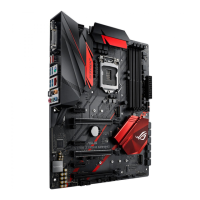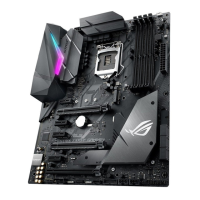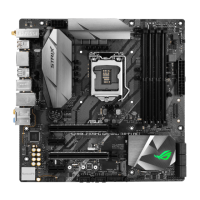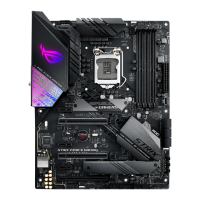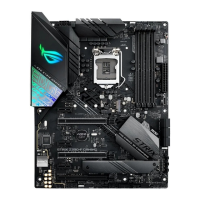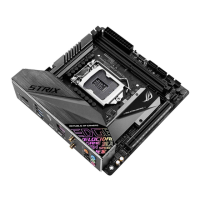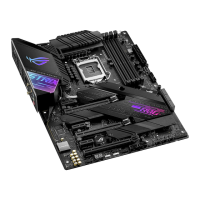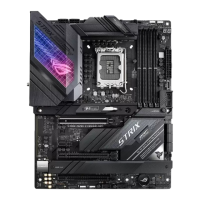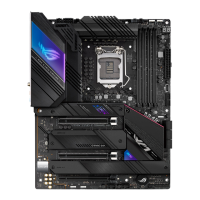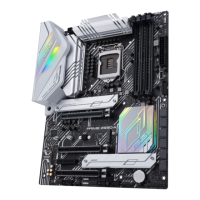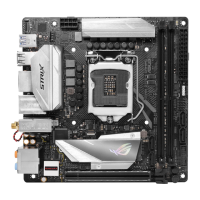
Do you have a question about the Asus ROG STRIX Z370-I GAMING and is the answer not in the manual?
| Brand | Asus |
|---|---|
| Model | ROG STRIX Z370-I GAMING |
| Category | Motherboard |
| Language | English |
Overview of the motherboard features, switches, jumpers, and connectors.
Important precautions before installing components or changing settings.
Diagram and identification of motherboard connectors, jumpers, and slots.
Details on the LGA1151 CPU socket and installation precautions.
Information on DDR4 DIMM slots and memory configurations.
Details on PCIe x16 slots and M.2 X16 card configuration.
Explanation of the Clear RTC RAM jumper and its function.
Description of POST State LEDs and RGB LED lighting control.
Details on SATA connectors, front panel audio, USB, and fan connectors.
Step-by-step guide for assembling PC components onto the motherboard.
Instructions for installing the motherboard into the PC chassis.
Detailed steps and precautions for installing the CPU into the socket.
Guide for installing the CPU heatsink and fan assembly.
Instructions for installing and removing RAM modules (DIMMs).
Connecting the ATX power supply connectors to the motherboard.
Instructions for connecting SATA storage devices.
Connecting front panel connectors for USB, audio, and power buttons.
Steps for installing PCIe x16 expansion cards.
Guide for installing M.2 SSD modules into the M.2 sockets.
Instructions for connecting the Wi-Fi antenna to the motherboard.
Description of rear panel I/O ports and audio connections.
Identification and description of the rear panel connectors.
Diagram showing audio port connections for various channel configurations.
Procedures for initial system startup after assembly and connection.
Methods for properly shutting down or putting the system into sleep mode.
Introduction to UEFI BIOS and its role in system configuration.
How to enter and navigate the BIOS setup utility.
Overview of the simplified BIOS interface for basic settings.
Accessing and understanding the advanced BIOS configuration options.
Manual configuration of CPU and chassis fan speeds.
Automated CPU/DRAM overclocking and RAID setup wizard.
Personalizing the BIOS by saving frequently used items.
Overview of basic system information and security settings.
Configuring overclocking-related settings for CPU and DRAM.
Detailed configuration options for CPU, system devices, and storage.
Adjusting ASPM for PCH and SA PCI Express.
BIOS settings related to CPU features and power management.
Adjusting link speed for PEG Port and Multi-Monitor.
Adjusting PCH PCI Express speed.
Configuring SATA controller modes and storage devices.
Enabling/disabling onboard devices like Audio, LAN, and RGB LED.
Setting system wake and sleep configurations (ErP Ready).
Configuring IPv4/IPv6 PXE support.
Displaying SMART information for connected storage devices.
Managing USB ports and features, including single port control.
Monitoring system temperature, power status, and fan settings.
Configuring system boot options, including Fast Boot and CSM.
Accessing special function utilities like EZ Flash and Secure Erase.
Updating the BIOS using a USB flash drive or the Internet.
Safely cleaning SSDs to restore factory performance levels.
Saving and loading BIOS settings profiles for overclocking.
Viewing DRAM SPD (Serial Presence Detect) information.
Displaying installed graphics card information.
Loading default settings, saving, or discarding BIOS changes.
Procedures and utilities for updating the motherboard BIOS.
Updating BIOS from within the Windows environment.
Updating BIOS via storage device or internet connection.
Recovering a corrupted BIOS file from support DVD or USB.
Overview of RAID technologies supported by the motherboard.
Explanations of RAID levels: RAID 0, 1, 5, and 10.
Guidelines for installing SATA hard disks for RAID arrays.
Configuring RAID settings within the UEFI BIOS.
Accessing and using the Intel RST Option ROM utility.
Steps to create a RAID driver disk for OS installation.
Procedure for creating a RAID driver disk in Windows.
Regulatory notices, including FCC statements and compliance information.
FCC compliance statement regarding interference and operation.
Canadian ISED compliance statements for digital apparatus.
Information regarding REACH compliance and product disposal.
Warning about RF exposure and required installation distances.

